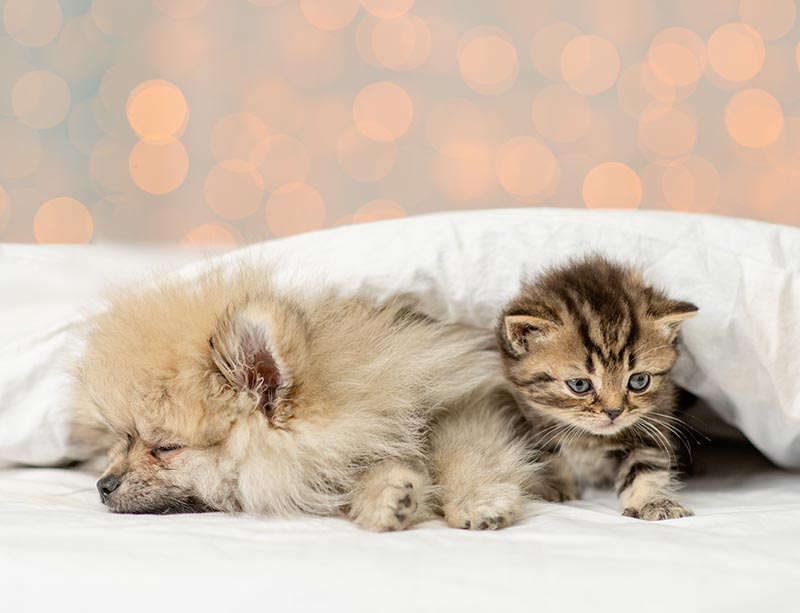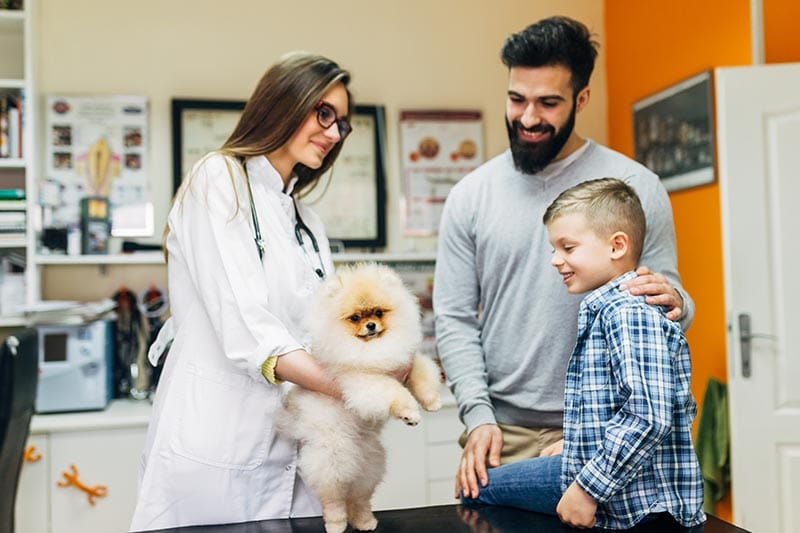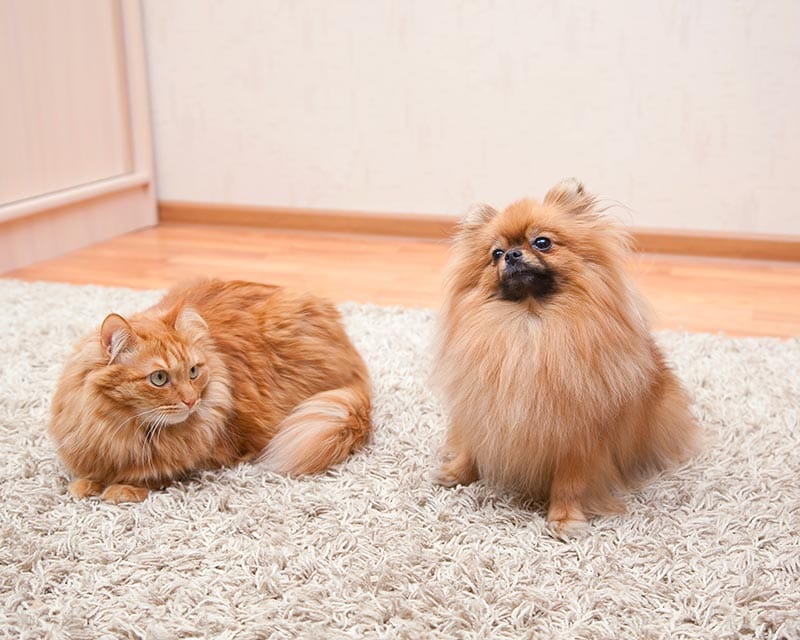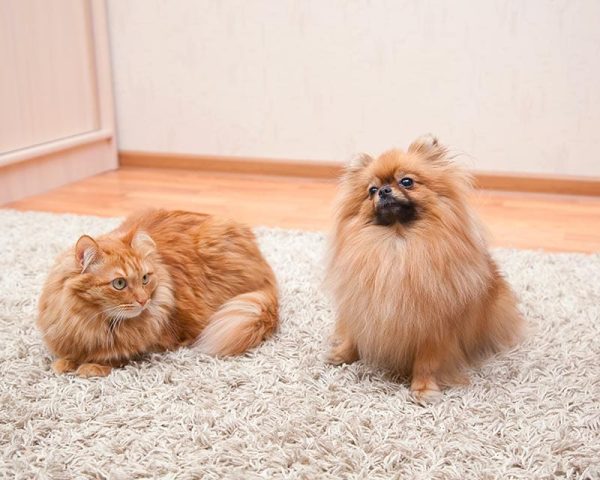Pomeranians are known for their signature fluffy coats, tiny statures, winning hearts, and dog show success. But, like many toy breeds, their ability to play nice with others can take time to determine! Unlike some other toy dogs, Pomeranians are generally regarded as brave and bold but friendly, meaning they will likely be good with (dog-savvy) cats in the home.
However, the ability for your Pom to get on well with your cat comes with a few caveats. Read on to learn what these are and what could influence how good a Pomeranian will be with your cat!

What Are Pomeranians Like With Cats?
Typically, Pomeranians are friendly toward cats. They’re usually willing to interact and bond with them since they were bred for friendliness and companionship. Pomeranians are tiny and outgoing, with friendly and open personalities that usually pair well with other pets in the home.
They aren’t known for having a high chase drive, and they are loyal and loving with their families. These qualities make it more likely that a Pom will get along well with your cat, but their vivaciousness and energy might be too much for some chilled-out cats!
The same Pom and cat dynamic will differ with each pairing because the Pomeranian and the cat are individuals. Some Pomeranians will love nothing more than snuggling up beside a cat and doing everything together. However, there might be Poms with higher prey drives that can’t help but chase every cat they see.


How Can I Help My Pomeranian Be Good With My Cat? 4 Key Steps
Good introductions are critical to a long-lasting, positive relationship between cats and dogs. A slow and steady introduction can give you the best chance of setting up for success.
1. Before You Start
Before you bring a new Pomeranian or cat into the home, set up a place for each pet to escape to if needed. Cats, in particular, will need somewhere to remove themselves from your Pom if things get too stressful. High places are ideal for your cat to get to if they need to get out of your Pomeranian’s way quickly, and they can help your cat feel secure.
You’ll need to be present to monitor all interactions for the first month or so. By giving your pets gentle praise and talking to them calmly, you can help them feel safe during the interaction periods and help them remain calm.
2. Introduce Them From Afar First
When you first bring your new cat or Pomeranian home, ensure they’re separated and cannot see each other. The goal is to get them both used to the other’s presence without face-to-face interaction, as you can control the quality of the interactions better this way and build positive associations. In addition, your cat and Pom will be able to hear and smell one another through closed doors, so keeping them in separate rooms is a good way to begin introductions safely.
Feeding your cat and Pomeranian on opposite sides of the door is a good starting point for introductions, as they’ll hear and smell one another but will begin to associate this with good things (yummy food). Start by placing the bowls away from the door, and get closer and closer each time. By the end of the process, your cat and Pomeranian should be eating calmly against the door.
3. Start Face-to-Face Meetings
When your pets are calmly eating at the door, you can introduce them in short sessions. Make sure this is done in a “neutral” part of the house that’s away from your cat’s or Pomeranian’s safe areas. Keep it calm, and don’t restrain either pet, as this can cause tension or result in injury. Having your Pom on a loose leash is a good idea, so you have control if something goes awry, but allow your cat to come and go as they want.
Watch them closely and have treats on hand as rewards for calm behavior. Asking your Pom to sit or lie down is an excellent way to calm them. If you notice any signs of aggression, distract them and go back to the previous stage in the process.
4. Repeat, Repeat, Repeat
These sessions should be done daily for longer durations each time. Take your time with this stage, as slow and steady interactions are the best way to help your Pomeranian be good with your cat. When you think they’re ready and no signs of aggression have been observed, you can remove your Pom’s leash and allow it to roam the room freely. It’s best not to leave your cat and Pom alone unsupervised, as incidents can still occur, and either party can be injured.


Are My Pomeranian and Cat Getting Along?
Cats and dogs have complex methods of communication, and they might not always translate well across the species. However, there are some tell-tale positive and negative signs that humans can understand.
Signs Your Pomeranian and Cat Are Getting Along
Some signs that the relationship is going well and your cat and Pomeranian are bonding include.
- Sleeping together
- Allogrooming (licking/allowing the other to lick them)
- Playing (not to be confused with fighting)
- Following one another around in a relaxed way
- General relaxed body language
Remember that even if your Pomeranian and cat have gotten along well for a long while, they are still animals. They can still get wires crossed or overstep some boundaries and may act aggressively toward one another.
Signs Your Pomeranian and Cat Aren’t Getting Along
The signs of aggression in cats and dogs are usually pronounced and easy to recognize, and a lot of that will come from fear. Dogs are naturally inclined to chase small furry things, and cats are inclined to run. It’s essential to recognize the early signs of aggression in either species so you can ensure both family members are safe and can begin to work on the relationship.
- Growling
- Lunging
- Hissing or barking
- Raised hackles
- Swiping
- Dilated pupils (in cats) and eye-whites showing (in dogs)
- Charging
- Ears flattened

What Do I Do if My Pomeranian Isn’t Good With My Cat?
If your Pomeranian and cat aren’t getting along, you can ask your veterinarian for advice. They should be able to give you pointers and refer you to an animal behaviorist who can help you deal with aggression, but sometimes these problems cannot be overcome.
Improvements to the relationship can be made, but there are situations in which the best result for everyone involved is, sadly, rehoming either the cat or the Pomeranian.


Conclusion
Pomeranians are a toy breed and are very companionable by nature, and most should be good with cats if introduced properly. Each relationship will depend on the individuals’ personalities, as some cats won’t tolerate dogs and vice versa. Because Poms are small, they may seem less threatening to cats and thus be better positioned to bond with them, but don’t rely on this.
Despite their small size, a Pomeranian could easily cause harm to a cat, and a cat could seriously harm a Pom. However, if all introductions are done correctly, your dog and cat will hopefully live a peaceful and happy life together.
See Also:
- Spanish Dog Names With Meanings for Male & Female Dogs
- Cute Dog Names: Best Tiny, Squishy & Adorable Ideas
Featured Image Credit: Olesya Kuznetsova, Shutterstock
Contents
- What Are Pomeranians Like With Cats?
- How Can I Help My Pomeranian Be Good With My Cat? 4 Key Steps
- 1. Before You Start
- 2. Introduce Them From Afar First
- 3. Start Face-to-Face Meetings
- 4. Repeat, Repeat, Repeat
- Are My Pomeranian and Cat Getting Along?
- What Do I Do if My Pomeranian Isn’t Good With My Cat?
- Conclusion










